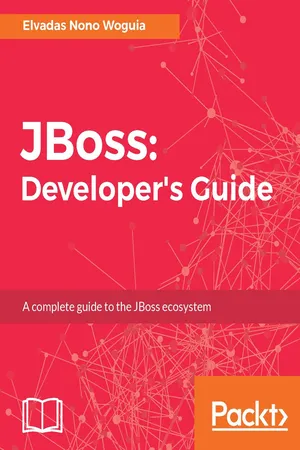
- 328 pages
- English
- ePUB (mobile friendly)
- Available on iOS & Android
JBoss: Developer's Guide
About This Book
Build your own enterprise applications and integration flows with JBoss and its productsAbout This Book• Build fast, smart, and flexible applications using JBoss• Couple one or more JBoss products to effectively solve various business problems• Explore the JBoss product ecosystem for improving the performance of your projectsWho This Book Is ForIf you are a Java developer who wants to have a complete view of the JBoss ecosystem or quickly explore a specific JBoss Product, then this is the book you want. Integrators and consultants, familiar with JBoss, who want integrate several JBoss products within their ongoing project will also find this book useful.What You Will Learn• Create new applications or integrate existing systems with JBoss products• Setup and manage a JBoss domain• Setup and manage a JBoss Fuse cluster with Fabric and Apache Karaf• Create and deploy OSGi applications on JBoss Fuse containers• Manage enterprise data with JBoss Datagrid• Aggregate various data sources with JBoss Data virtualization to offer data as a service• Optimize your business and workflows with both JBoss Business RulesManagement System and JBoss Business Process Management platforms.In DetailHave you often wondered what is the best JBoss product to solve a specific problem? Do you want to get started with a specific JBoss product and know how to integrate different JBoss products in your IT Systems? Then this is the book for you.Through hands-on examples from the business world, this guide presents details on the major products and how you can build your own Enterprise services around the JBoss ecosystem.Starting with an introduction to the JBoss ecosystem, you will gradually move on to developing and deploying clustered application on JBoss Application Server, and setting up high availability using undertow or HA proxy loadbalancers.As you are moving to a micro service archicture, you will be taught how to package existing Java EE applications as micro service using Swarm or create your new micro services from scratch by coupling most popular Java EE frameworks like JPA, CDI with Undertow handlers.Next, you will install and configure JBoss Data grid in development and production environments, develop cache based applications and aggregate various data source in JBoss data virtualization.You will learn to build, deploy, and monitor integration scenarios using JBoss Fuse and run both producers/consumers applications relying on JBoss AMQ.Finally, you will learn to develop and run business workflows and make better decisions in your applications using Drools and Jboss BPM Suite Platform.Style and ApproachThe book works through the major JBoss products, with examples and instructions to help you understand each product and how they work together.
Frequently asked questions
Information
Integrating Applications with JBoss Fuse
- Complex event processing
- Messaging and interoperability
- Routing and service orchestration
JBoss Fuse architecture

- Properties, placeholders, and configuration files for applications deployed on theFuseOnEAP/Fuse standalone Karaf installation
- Profiles and JVM containers for Fabric8 deployments
- Config maps, secrets, templates, and image deployments on pods for Openshift/Kubernetes installation
Installing JBoss Fuse
Basic Fuse installation
$ unzip jboss-fuse-karaf-6.3.0.redhat-187.zip
$ cd jboss-fuse-6.3.0.redhat-187/
Table of contents
- Title Page
- Copyright
- Credits
- About the Author
- About the Reviewer
- www.PacktPub.com
- Customer Feedback
- Preface
- Introduction to the JBoss Ecosystem
- Developing and Hosting Scalable Web Applications
- Custom Web Deployment using Undertow and Swarm
- Storing and Accessing Distributed Data
- Exposing Data as a Service
- Integrating Applications with JBoss Fuse
- Delivers Information Safely and Connects IoT
- Making Better Decisions in Your Applications
- Developing Workflows